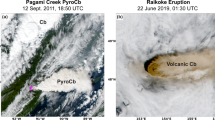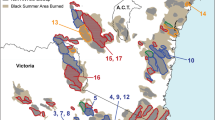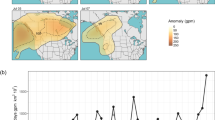Abstract
AN impressive amount of evidence supports the proposal of Alvarez et al.1,2 that the Cretaceous era was ended abruptly by the impact of a comet or asteroid. The recent discovery3,4 of an apparently global soot layer at the Cretaceous/Tertiary boundary indicates that global wildfires were somehow ignited by the impact. Here we show that the thermal radiation produced by the ballistic re-entry of ejecta condensed from the vapour plume of the impact could have increased the global radiation flux by factors of 50 to 150 times the solar input for periods ranging from one to several hours. This great increase in thermal radiation may have been responsible for the ignition of global wildfires, as well as having deleterious effects on unprotected animal life.
This is a preview of subscription content, access via your institution
Access options
Subscribe to this journal
Receive 51 print issues and online access
$199.00 per year
only $3.90 per issue
Buy this article
- Purchase on Springer Link
- Instant access to full article PDF
Prices may be subject to local taxes which are calculated during checkout
Similar content being viewed by others
References
Alvarez, W. Eos 67, 653–655 (1986).
Alvarez, L. W., Alvarez, W., Asaro, F. & Michel, H. V. Science 208, 1095–1108 (1980).
Wolbach, W., Lewis, R. S. & Anders, E. Science 230, 167–170 (1985).
Wolbach, W. S., Gilmour, I., Anders, E., Orth, C. J. & Brooks, R. R. Nature 334, 665–669 (1988).
Emiliani, C., Kraus, E. B. & Shoemaker, E. M. Earth planet. Sci. Lett. 55, 317–334 (1981).
Melosh, H. J. Impact Cratering: A Geologic Process 1–245 (Oxford University Press, 1989).
O'Keefe, J. D., Ahrens, T. J. & Koschny, D. in Global Catastrophes in Earth History 133–134 (Lunar and Planetary Institute, Snowbird, Utah, 1988).
Smit, J. & Klaver, G. Nature 292, 47–49 (1981).
Montanari, A. et al. Geology 11, 668–671 (1983).
Bohor, B. F., Modreski, P. J. & Foord, E. E. Science 236, 705–709 (1987).
Melosh, H. J. & Vickery, A. M. Nature 338, 487–489 (1989).
Vickery, A. M. & Melosh, H. J. in Global Catastrophes, Geol. Soc. Am. Spec. Pap. (in the press).
Jones, E. M. & Kodis, J. W. in Geological Implications of Impacts of Large Asteroids and Comets on the Earth, Geol. Soc. Am. Spec. Pap. 190, 175–186 (1982).
Argyle, E. Icarus 77, 220–222 (1989).
O'Keefe, J. D. & Ahrens, T. J. in Geological Implications of Impacts of Large Asteroids and Comets on the Earth, Geol. Soc. Am. Spec. Pap. 190, 103–120 (1982).
Melosh, H. J. in Geological Implications of Impacts of Large Asteroids and Comets on the Earth, Geol. Soc. Am. Spec. Pap. 190, 121–127 (1982).
Kyte, F. T. Smit, J. & Wasson, J. T. Earth planet. Sci. Lett 73, 183–195 (1985).
Bohor, B. F., Triplehorn, D. M., Nichols, D. J. & Millard, H. T. J. Geology 15, 896–899 (1987).
Glasstone, S. & Dolan, P. J. Effects of Nuclear Weapons Table 7.40 (US Departments of Defense and Energy, Washington, DC, 1977).
Bate, R. D., Mueller, D. D. & White, J. E. Fundamentals of Astrodynamics (Dover, New York, 1971).
Whipple, F. L. Proc. Natn. Acad. Sci. U.S.A. 36, 687–695 (1950).
Brownlee, D. E. A. Rev. Earth planet. Sci. 13, 147–173 (1985).
Chamberlain, J. W. & Hunten, D. M. Theory of Planetary Atmospheres 1–481 (Academic, Orlando, 1987).
Zahnle, K. J. in Global Catastrophes, Geol. Soc. Am. Spec. Pap. (in the press).
LaRocca, A. L. in The Infrared Handbook (eds Wolfe, W. L. & Zissis, G. J.) 5.1–5.132 (Office of Naval Research, Alexandria, Virginia 1978).
Holton, J. R. Introduction to Dynamic Meteorology 2nd edn, 1–391 (Academic, New York, 1979).
Hildebrand, A. R. & Wolbach, W. S. Lunar planet. Sci. Conf. XX (abstr.) 414–415 (1989).
Martin, S. Proc. 10th Symp. (Int.) on Combustion 877–896 (Williams and Wilkins, Baltimore, 1965).
Simms, D. L. & Law. M. Combust. Flame 11, 377–388 (1967).
Simms, D. L. Combust. Flame 7, 253–261 (1963).
Argyle, E. Science 234, 261 (1986).
Author information
Authors and Affiliations
Rights and permissions
About this article
Cite this article
Melosh, H., Schneider, N., Zahnle, K. et al. Ignition of global wildfires at the Cretaceous/Tertiary boundary. Nature 343, 251–254 (1990). https://doi.org/10.1038/343251a0
Received:
Accepted:
Issue Date:
DOI: https://doi.org/10.1038/343251a0
This article is cited by
-
A review of common natural disasters as analogs for asteroid impact effects and cascading hazards
Natural Hazards (2023)
-
Timing and causes of forest fire at the K–Pg boundary
Scientific Reports (2022)
-
The Chicxulub impact and its environmental consequences
Nature Reviews Earth & Environment (2022)
-
Delayed and variable late Archaean atmospheric oxidation due to high collision rates on Earth
Nature Geoscience (2021)
-
H. J. Melosh
Nature Astronomy (2020)
Comments
By submitting a comment you agree to abide by our Terms and Community Guidelines. If you find something abusive or that does not comply with our terms or guidelines please flag it as inappropriate.



